
Goblins in Tolkien's Middle-earth: Tricksters, Terrors, and the Truth
Unveiling the Origins and Mysteries of Goblins in J.R.R. Tolkien's World
The True Nature of Goblins in Middle-earth
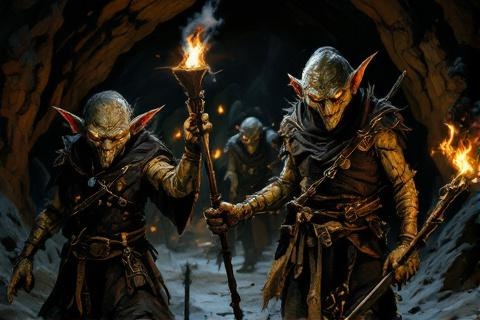
In J.R.R. Tolkien's rich world of Middle-earth, goblins
emerge as one of the most memorable antagonistic races, particularly in "The
Hobbit" where they play a significant role in
Bilbo's adventures. These malevolent creatures dwell
primarily in the dark tunnels and caverns of the Misty Mountains, creating vast
underground networks away from the sunlight they detest. When Thorin
Oakenshield's company traversed the High Pass
through the Misty Mountains, they were captured by these mountain-dwelling
creatures and brought before their king. Goblins in Tolkien's works are not
solitary monsters but organized societies with their own culture, albeit a cruel
one focused on causing pain and suffering to others. Their hatred of dwarves
stemmed from ancient conflicts, including the Goblin-Dwarf War that followed the
death of the dwarf-king Thrór, making them particularly eager to capture
Thorin's company.
While casual readers might distinguish between goblins and orcs, in Tolkien's
legendarium these terms are essentially interchangeable, referring to the same
species of corrupted beings. "The Hobbit," written with a more accessible
narrative style intended for children, predominantly uses the term "goblin,"
which evokes familiar creatures from European folklore. In contrast, the more
adult-oriented "The Lord of the Rings" and "The Silmarillion" favor the term
"orc," derived from Old English or possibly influenced by Latin "orcus" (hell).
This distinction in terminology does not indicate different creatures but
reflects the different intended audiences and narrative tones of the books.
Tolkien himself confirmed this equivalence in his letters and notes, while
sometimes suggesting that "goblin" might refer to smaller orcs of the Misty
Mountains specifically, though this distinction is not consistently maintained
throughout his works.
Tolkien describes goblins as smaller and more nimble than the larger uruk-hai
orcs that appear in later works. They possess sallow skin, wide mouths filled
with sharp fangs, long arms, and crooked legs. Their eyes are notably adapted to
darkness, allowing them to see in near-complete blackness but causing them pain
in bright sunlight. Despite their grotesque appearance and malevolent nature,
goblins demonstrate considerable intelligence and skill, particularly in
developing machines, creating elaborate tunnel systems, and devising instruments
of torture. Their technological aptitude manifests in various cruel inventions
designed to inflict suffering, such as the "ingenious machines" mentioned in
"The Hobbit" that were "made by cunning minds of old that had lain long and
forgotten in the deep places of the mountains." This talent for mechanical
innovation, though perverted toward evil purposes, demonstrates that goblins
retained certain abilities from their original form before corruption.
Origins in the First Age: The Corruption of Elves

According to "The Silmarillion," Tolkien's comprehensive mythology of
Middle-earth, goblins or orcs were not created as a distinct species but rather
originated as Elves who were captured and tortured by
Morgoth, the first and greatest Dark Lord. This tragic
origin is mentioned when Tolkien writes, "the Orcs were bred by
Melkor of the subterranean heats and slime. Their hearts were of granite and
their bodies deformed; foul their faces which smiled not, but their laugh that
of the clash of metal, and to nothing were they more fain than to pain and the
wounding of things that lived." This corruption of the Firstborn Children of
Ilúvatar represents one of the most heinous acts of Morgoth, as he could not
create life himself but could only twist and pervert what already existed. The
revelation that these wretched creatures were once the beautiful and immortal
Elves serves as one of the most tragic elements in Tolkien's mythology.
The corruption of Elves into orcs occurred during the Years of the
Trees, a primordial era in Tolkien's timeline that
preceded the First Age of Middle-earth. This dark
transformation took place after Morgoth destroyed the Two Lamps that initially
illuminated the world and before the creation of the Sun and Moon. During this
period, Morgoth established his first fortress of Utumno in the
far north of Middle-earth, where he began capturing wandering Elves who had not
yet completed the Great Journey to Valinor. These early days
were marked by darkness and fear as many Elves disappeared without trace, taken
to the pits of Utumno where unspeakable torments awaited them. The darkness of
this era provided the perfect cover for Morgoth's foul deeds, as the world was
illuminated only by the distant light of the Two Trees in Valinor, which did not
reach the far corners of Middle-earth where his influence was strongest.
Through dark arts and unimaginable cruelty, Morgoth systematically twisted these
captured Elves, breaking their bodies and spirits until they became a mockery of
their former selves. In "The Silmarillion," Tolkien describes how Morgoth "by
slow arts of cruelty... corrupted them, and enslaved them, and by his evil arts
made of them the hideous race of the Orcs, mocking the Children of Ilúvatar."
This process involved both physical torture and spiritual corruption, as Morgoth
sought to imbue these beings with his own malice and hatred, particularly toward
the Elves who remained free. The transformation was so complete that these
corrupted beings no longer resembled Elves in appearance or spirit, becoming
instead creatures of darkness who hated light and beauty. Their immortal Elvish
nature was perverted as well, though debate exists among Tolkien scholars about
whether orcs retained some form of the Elvish immortality or if their lifespan
was diminished through Morgoth's corruption.
This origin story of goblins as corrupted Elves reflects one of Tolkien's
central philosophical and theological themes: that evil cannot truly create, but
only corrupt what is good. Throughout his legendarium, Tolkien consistently
portrays evil as parasitic and derivative rather than creative or original.
Morgoth, though the most powerful of the Valar (angelic powers),
could not create life from nothing as only Ilúvatar (God) possessed this
ability. Instead, he could only twist and pervert existing creations, turning
them into shadows of their former selves. This concept aligns with Tolkien's
Catholic worldview, which views evil not as an equal opposing force to good but
as a corruption or absence of good. The goblins thus stand as one of the most
potent symbols of this theme in Tolkien's work, representing how even the most
beautiful of creations can be corrupted through malice and cruelty, while
simultaneously demonstrating evil's fundamental inability to create anything
truly new or original.
Goblin Technology and Craftsmanship
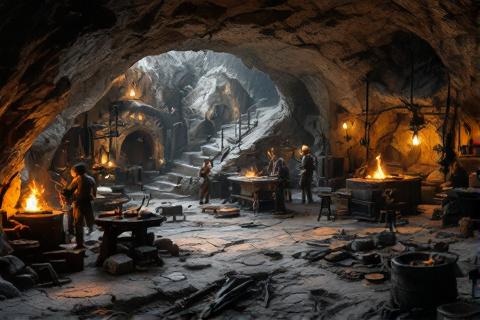
Despite their corruption from their original Elvish nature, goblins retained and
perverted the innate Elvish skill for crafting that was characteristic of the
Firstborn. Where Elves created objects of beauty and harmony with nature,
goblins twisted these talents toward destruction, pain, and exploitation of the
natural world. This perversion of crafting ability manifests most clearly in
their weapons and tools, which demonstrate considerable skill but are invariably
designed to maximize suffering rather than efficiency or elegance. In "The
Hobbit," Tolkien notes that goblins "invented some of the machines that have
since troubled the world, especially the ingenious devices for killing large
numbers of people at once." This dark creativity reflects their corrupted
nature, as they retain the intelligence and crafting aptitude of their Elvish
ancestors but direct these talents exclusively toward harmful ends. Their crafts
reveal an ability to innovate and solve problems, but always with malicious
intent rather than for creation or healing.
In "The Hobbit," Tolkien provides glimpses of the goblins' technological
capabilities, describing their ingenious machines designed for torture and their
remarkable ability to tunnel efficiently through mountain stone. The goblin-town
visited by Bilbo and the dwarves featured numerous chambers and passageways
carved into the living rock, illuminated by red fires that cast eerie shadows
across the cavern walls. Their mining operations were extensive, with tunnels
branching out in all directions through the Misty Mountains, creating a vast
underground network that allowed them to traverse great distances while
remaining hidden from sunlight. Tolkien writes that "it was not long before all
the goblins of the mountains were in uproar and were busy hunting, and those
that were not hunting were busy arming themselves," demonstrating their ability
to rapidly mobilize through these extensive tunnel systems. Their machines
included various contraptions for mining, torture devices with "cruel hooks and
claws," and rudimentary but effective traps designed to capture unwary travelers
who ventured into their territory.
Goblin-made weapons were crafted with both cunning and cruelty in mind,
typically crude in appearance but devastatingly effective in function. Their
armaments commonly featured curved blades designed to cause jagged,
difficult-to-heal wounds, hooks that could tear flesh, and occasionally poisoned
tips to inflict additional suffering on their victims. In "The Lord of the
Rings," the goblin chieftain in Moria wielded a spear with a broad blade that
nearly killed Frodo Baggins, saved only by his hidden mithril mail shirt. Unlike
the straight, elegant blades of Elves or the sturdy, reliable weapons of
Dwarves, goblin weapons emphasized pain and terror over
craftsmanship. Tolkien described their equipment as "scimitars, crooked knives,
spike-clubs, and other hideous devices," reflecting their preference for weapons
that would not only kill but mutilate and torture. Despite their crude
appearance, these weapons were functional and dangerous, demonstrating the
goblins' perverse talent for creating instruments of destruction.
Goblins showed particular aptitude for fire-making, mining, and creating traps
for unwary travelers who ventured too close to their territories. Their ability
to work with fire was notable, as they maintained forges deep within their
mountain homes where they crafted their weapons and tools. This affinity for
fire stood in stark contrast to their hatred of sunlight, as they controlled
fire for destructive purposes while fearing the natural light of the sun. Their
mining skills allowed them to create vast networks of tunnels throughout the
Misty Mountains, with chambers large enough to house entire goblin communities,
including the throne room of the Great Goblin. These tunnel systems were often
booby-trapped with trip wires, pit falls, and other deadly surprises designed to
capture or kill intruders. In "The Hobbit," Bilbo and the dwarves narrowly
escaped such traps when fleeing from the goblin-town, highlighting how the
goblins' environmental engineering served both defensive and offensive purposes.
Their skillful manipulation of their underground environment made their
territories exceptionally dangerous for outsiders to navigate without falling
prey to their carefully designed hazards.
The Great Goblin and Governance
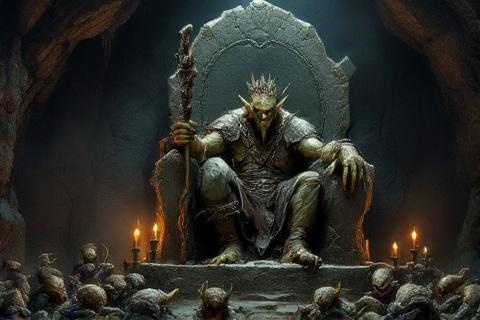
Goblin society as portrayed in "The Hobbit" exhibited a clearly hierarchical
leadership structure, with the Great Goblin ruling over the colony in the Misty
Mountains with absolute authority. This social organization reflected a brutal
meritocracy where strength, cunning, and cruelty determined one's position in
the hierarchy. Beneath the Great Goblin were various captains and lieutenants
who commanded smaller groups of goblins and enforced his will throughout the
extensive network of tunnels and caverns. When Thorin's company was captured and
brought before the Great Goblin, they witnessed a court-like gathering where
lesser goblins served and feared their king, bringing prisoners before him for
judgment and carrying out his orders without question. This structured society
demonstrates that despite their chaotic and evil nature, goblins maintained
complex social organizations that allowed them to coordinate their activities
across vast underground territories. Their hierarchical system enabled them to
mount organized military campaigns and maintain control over extensive
territories, making them far more dangerous than if they had been merely
solitary monsters.
The Great Goblin himself is vividly described in "The Hobbit" as a formidable
figure with a huge head and wearing a crown made of bone, emphasizing both his
physical power and his status as ruler. Tolkien writes that he was "a tremendous
goblin with a huge head" who sat on a large flat stone with "goblins on each
side of him carrying the burning brands of pinewood." His grotesque appearance
embodied the corrupted nature of goblin-kind, while his ornaments and trappings
of leadership, including the bone crown, demonstrated the perverse value system
of goblin society that prized dominance and the ability to inspire fear. When
Gandalf slew the Great Goblin during the rescue of
Thorin's company, the other goblins reacted with momentary shock and disarray,
showing how central his leadership was to maintaining order in their society.
The bone crown symbolized not just leadership but the goblin value system that
celebrated death and suffering, a twisted mockery of the noble crowns worn by
the kings of Elves, Men, and Dwarves.
Goblin leadership throughout their society was maintained through fear, physical
strength, and cunning rather than through concepts of loyalty or honor that
characterized the leadership structures of other races in Middle-earth. Their
leaders constantly needed to demonstrate their power and cruelty to maintain
control over their subordinates, who would quickly challenge and overthrow any
leader perceived as weak. This created a perpetual state of internal competition
and treachery within goblin ranks, with ambitious lesser goblins always looking
for opportunities to usurp their superiors. In "The Lord of the Rings," Tolkien
elaborates on this aspect of orc society, showing how even in
Mordor under Sauron's ultimate authority,
orc captains maintained discipline through threats and violence rather than
respect or devotion to their cause. When the Great Goblin was killed, another
leader, Bolg son of Azog, quickly emerged to unite the goblins for the Battle
of Five Armies, demonstrating how their
leadership structure could rapidly reorganize when necessary. This ruthless
system of governance ensured that only the most vicious and cunning goblins rose
to positions of power, reinforcing the cruel nature of their society as a whole.
Language and Communication
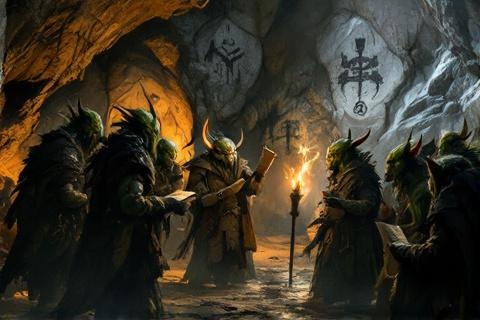
Goblins spoke a corrupted language called the Black Speech, which was created by
Sauron during the Second Age as part of his effort to unify the various evil
creatures under his command. The most famous example of this language appears in
the inscription on the One Ring: "Ash nazg durbatulûk, ash nazg gimbatul, ash
nazg thrakatulûk agh burzum-ishi krimpatul," which translates to "One Ring to
rule them all, One Ring to find them, One Ring to bring
them all and in the darkness bind them." Sauron designed the Black Speech to be
a unifying tongue for all his servants, particularly the orcs and goblins who
previously had no common language. The harsh sounds and guttural pronunciation
of the Black Speech reflected its evil origins and purpose, standing in stark
contrast to the melodious languages of the Elves. When Gandalf spoke the ring
inscription in the Black Speech during the Council of Elrond, those present felt
a chill and darkness seemed to temporarily dim the light in the room,
demonstrating the inherent malevolence embedded in the very sounds and structure
of this language.
In practice, different tribes of goblins developed their own dialects of the
Black Speech, resulting in a fragmented linguistic landscape that reflected
their disunity and tendency toward tribal isolation. These dialects evolved as
goblin groups became separated and developed in different regions, incorporating
elements from other languages they encountered including Westron (the Common
Tongue), various Elvish languages, and even Dwarvish terms. Despite these
dialectical differences, goblins from different regions could communicate with
each other when necessary, particularly in times of war when different tribes
united against common enemies. The goblin songs heard by Bilbo in "The Hobbit"
represent a form of this corrupted language put to verse, with their chants of
"Clap! Snap! the black crack! / Grip, grab! Pinch, nab!" demonstrating both
their linguistic style and their violent cultural values. These tribal
variations in language reinforced the social boundaries between different goblin
communities and contributed to the constant internal conflicts that
characterized their societies across Middle-earth.
Beyond their own corrupted tongue, goblins were capable of learning and speaking
the Common Tongue (Westron), albeit in a debased form characterized by
simplified grammar and vulgar expressions. This linguistic adaptability proved
useful for interrogating prisoners, communicating with other servants of evil,
and occasionally for limited trade with unscrupulous humans. In "The Lord of the
Rings," the orcs of Mordor and the Uruk-hai of Saruman conversed in a crude form
of Westron, which allowed Merry and Pippin to understand their captors'
conversations while being transported to Isengard. Their use of the Common
Tongue typically incorporated numerous insults, threats, and crude expressions
that revealed their aggressive and hierarchical social structure. When speaking
Westron, goblins tended to use simple, direct phrases focused on immediate
concerns like food, fighting, and following orders, revealing their pragmatic
approach to communication as a tool for achieving immediate goals rather than
for preserving knowledge or expressing complex ideas.
Goblin speech, regardless of which language or dialect they were using, was
consistently described by Tolkien as harsh, grating, and filled with curses and
threats that reflected their malevolent nature. In "The Hobbit," the voices of
the goblins are characterized as "cruel, hard, and wicked," while their songs
contain gruesome imagery of torture and death. The phonetic qualities of their
speech included abundant gutturals, harsh consonants, and abrupt syllables that
created an unpleasant, threatening sound even to those who couldn't understand
the words themselves. This linguistic harshness contrasted dramatically with the
melodious, flowing speech of the Elves, further emphasizing the corruption that
transformed the First Children of Ilúvatar into these twisted creatures. Even
when attempting to sound friendly or reasonable, as when the Great Goblin
questioned Thorin about their presence in the mountains, their speech retained
an underlying menace and mockery that betrayed their true intentions. Tolkien, a
philologist deeply interested in how language reflects culture, deliberately
crafted the goblin manner of speaking to reveal their inner nature and the
corruption that defined their existence.
Goblin Warfare and Tactics
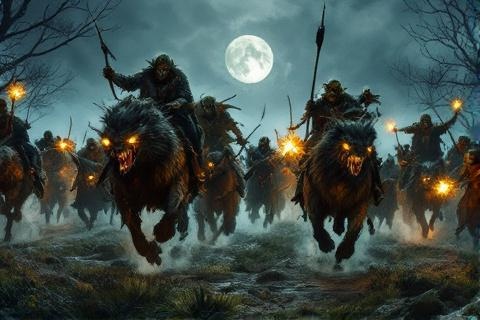
Goblins preferred ambush tactics and overwhelming numbers rather than direct
confrontation with stronger foes, reflecting both their physical limitations and
their cunning, opportunistic nature. Their military strategy typically involved
striking from hidden positions, often at night or in darkness when their
superior vision in low light gave them a significant advantage over their
enemies. In "The Hobbit," the goblins attacked Thorin's company after nightfall
when the dwarves had made camp in a cave that concealed a secret entrance to the
goblin tunnels. Rather than engaging in honorable combat, they waited until
their victims were asleep before capturing them. Similar tactics were employed
in "The Lord of the Rings" when the Fellowship was attacked in Moria, with
goblins first using a diversionary noise down a well to determine their location
before surrounding and ambushing them at Balin's Tomb. This preference for
attacking from surprise when their enemies were at their most vulnerable
demonstrated both their tactical intelligence and their disregard for the
concepts of fair combat or honorable warfare that were valued by other races of
Middle-earth.
To extend their military capabilities beyond their own physical limitations,
goblins formed alliances with other evil creatures, most notably riding upon
Wargs (large evil wolves) as described in both "The Hobbit" and "The Lord of the
Rings." These wolf-like creatures served as mounts that greatly increased the
goblins' speed and striking power, allowing them to cover vast distances quickly
and engage in hit-and-run tactics that would have been impossible on foot. The
partnership between goblins and Wargs represented a pragmatic alliance of
convenience between two evil species that shared common enemies and
complementary abilities. In "The Hobbit," this alliance proved particularly
dangerous when the goblins and Wargs together pursued Thorin's company, Gandalf,
and Bilbo through the forest and up into the trees. Tolkien described how
"wolves and goblins often helped one another in wicked deeds," highlighting the
practical nature of their cooperation rather than any genuine friendship or
loyalty. This willingness to form inter-species alliances for tactical advantage
demonstrated the goblins' pragmatism and cunning in warfare, making them more
dangerous than their individual capabilities might suggest.
The fighting style of goblins emphasized cruelty over honor, with their warriors
often using poison, traps, and darkness to their advantage rather than engaging
in the fair combat valued by Elves, Men, and Dwarves. Their weapons were
designed not just to kill but to cause maximum pain and suffering, including
barbed arrows, serrated blades, and poisoned tips that would ensure a slow,
agonizing death even from minor wounds. In battle, goblins would target the
weakest opponents first and focus on inflicting debilitating wounds that would
take enemies out of the fight rather than seeking the glory of defeating the
strongest warriors. They showed no mercy to the wounded and took particular
delight in torturing captives, as seen in their treatment of prisoners in their
mountain strongholds. This approach to warfare reflected their origin as
creatures corrupted by Morgoth, whose primary goal was not conquest but the
infliction of suffering for its own sake. Their battle tactics, like every other
aspect of their existence, were defined by malice and the desire to cause pain
rather than by strategic objectives or codes of conduct.
Though individually weaker than many of the free peoples of Middle-earth such as
Elves, Men, and Dwarves, goblins compensated for this disadvantage through their
sheer numbers, which made them dangerous opponents in large-scale conflicts.
Their rapid reproduction and relatively short maturation period allowed goblin
populations to recover quickly from losses and field large armies even after
significant defeats. In "The Hobbit," Tolkien describes how the goblins of the
Misty Mountains were able to gather "in incredible numbers" for the Battle of
Five Armies despite having suffered many casualties earlier in the narrative
when the Great Goblin was killed. Their numerical advantage often overwhelmed
the superior individual fighting skills of their opponents through simple mass
of attackers, as nearly happened to the Fellowship in Moria before they managed
to escape. This strength in numbers also allowed goblins to sustain casualties
that would have been unacceptable to other races, with their leaders willingly
sacrificing countless subordinates to achieve objectives or wear down enemy
forces. The combination of their numerical advantage, disregard for their own
casualties, and willingness to use underhanded tactics made goblin armies a
serious threat to the peace of Middle-earth despite their individual weaknesses.
Notable Encounters: Bilbo in Goblin-town
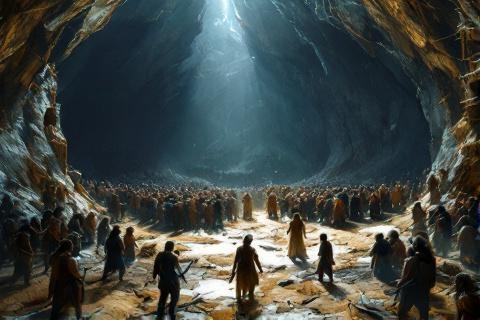
One of the most detailed accounts of goblins in Tolkien's legendarium comes from
Bilbo Baggins's adventure in "The Hobbit," when Thorin Oakenshield's company was
captured while sheltering in what turned out to be a concealed back door to the
goblin realm in the High Pass of the Misty Mountains. This encounter provides
readers with the most vivid description of goblin society and behavior in any of
Tolkien's works, serving as the primary source for understanding goblin culture.
The narrative describes how the dwarves and Bilbo were rudely awakened in the
middle of the night when "a crack appeared at the back of the cave" and goblins
emerged to capture them, dragging them "down dark corridors lit by red
torch-light" to the central chamber where the Great Goblin awaited. Through
Bilbo's eyes, readers experience the terror and confusion of being pulled
through narrow, twisting passages deep into the mountain, offering a
hobbit's perspective on these frightening creatures. This
first-hand account of goblin captivity reveals not only their cruelty and malice
but also their organization and intelligence, establishing them as formidable
antagonists rather than mindless monsters.
During this pivotal encounter in "The Hobbit," Tolkien introduces readers to
several distinctive elements of goblin culture, including their songs, their
underground town, and their vengeful nature after the death of their king. The
goblins sing cruel songs as they march their captives through the tunnels, with
lyrics like "Clap! Snap! the black crack! / Grip, grab! Pinch, nab!" that
celebrate violence and torment. These songs reveal the goblin aesthetic
sensibility, which finds beauty in pain and suffering rather than in harmony or
natural beauty. Their underground town is described as a complex settlement with
various chambers serving different purposes, illuminated by red firelight that
casts grotesque shadows across the cavern walls. After Gandalf kills the Great
Goblin during the rescue of Thorin's company, the goblins demonstrate their
tenacity and thirst for vengeance by pursuing the escapees relentlessly, showing
that despite their fear of light and preference for darkness, their hatred could
drive them to extraordinary efforts. This vengeful determination becomes a
significant plot element as the goblins continue to pursue the company and
eventually gather a massive army for the Battle of Five Armies, demonstrating
how personal grievances could escalate into large-scale conflicts in goblin
society.
The goblin tunnels that Bilbo navigated during his escape were described as a
complex maze of passages that wound through the mountains, eventually leading to
his fateful meeting with Gollum deep below the surface. Tolkien portrays these
tunnels as a disorienting labyrinth carved through living stone, with passages
branching in all directions and chambers of various sizes connected by narrow
corridors. Some tunnels were natural caverns expanded and modified by the
goblins, while others were entirely artificial, demonstrating their considerable
skill in mining and excavation. The lowest levels, where Bilbo encountered
Gollum, were described as ancient and largely forgotten even by the goblins
themselves, suggesting the extensive history of their underground realm. These
elaborate tunnel systems served multiple purposes for the goblin community,
providing defense against outside attacks, allowing them to move unseen through
the mountains, and giving them safe spaces away from the sunlight they detested.
Bilbo's journey through these passages, guided initially by luck and later by
his growing courage and resourcefulness, represents one of the most significant
challenges of his adventure, ultimately leading to his acquisition of the One
Ring that would later drive the events of "The Lord of the Rings."
The Battle of Five Armies and Goblin Alliances
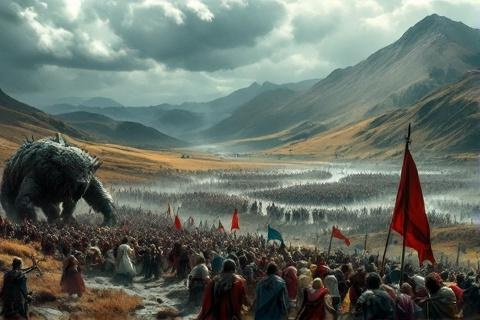
Following the death of Smaug the dragon in "The Hobbit," the
goblins of the Misty Mountains saw an opportunity for both vengeance and
plunder, uniting with their Warg allies to form a formidable army that marched
toward the Lonely Mountain. This unprecedented gathering of goblin forces
demonstrated their ability to coordinate across different tribes and colonies
when sufficient motivation existed. Tolkien describes how "tidings of the death
of the dragon and of the recovery of the treasure spread through all the north,"
reaching the ears of the goblins who immediately recognized the strategic
opportunity presented by Smaug's absence. The prospect of acquiring the vast
treasure of Erebor, combined with the chance to exact revenge
upon the dwarves for the death of the Great Goblin, provided powerful motivation
for the typically fractious goblin tribes to set aside their differences and
unite under a single banner. Their rapid mobilization and strategic thinking in
this situation revealed that despite their evil nature, goblins possessed
considerable organizational abilities and could act with unified purpose when
properly motivated by hatred and greed.
The massive goblin army that descended upon the Lonely Mountain was led by Bolg,
son of Azog, demonstrating the multi-generational hatred between goblins and
dwarves that fueled this conflict. This leadership choice was significant, as
Azog had killed Thrór, grandfather of Thorin Oakenshield, initiating a bloody
war between dwarves and goblins years before the events of "The Hobbit." Bolg's
position as commander highlighted how goblins maintained blood feuds across
generations, with sons inheriting the enemies and hatreds of their fathers.
Tolkien describes Bolg as "a huge goblin with many like him, swarms of them,"
indicating his physical dominance even among his own kind. Under his leadership,
the goblin army moved with surprising discipline and strategic coordination,
timing their attack to coincide with the standoff between the dwarves, elves,
and men at the foot of the mountain. This calculated approach showed Bolg's
tactical acumen, as he planned to eliminate all the free peoples in a single
decisive battle when they were already divided and in conflict with each other.
The generational aspect of this leadership illustrated how deeply ingrained the
animosity between goblins and dwarves had become, transcending individual lives
to become a defining element of their respective cultures.
The alliance between goblins and Wargs that characterized the army at the Battle
of Five Armies demonstrates how goblins would form pragmatic partnerships to
achieve their goals, setting aside potential rivalries when facing common
enemies. This coalition of evil creatures represented an unusual level of
cooperation among different species that typically operated independently,
highlighting the serious threat posed by the power vacuum created after Smaug's
death. Tolkien describes how "the Wargs came with the goblins, and the goblins
rode on the backs of the wolves," creating a highly mobile force that could
cover ground quickly and strike with both the strength of the goblins and the
natural weapons of their wolf-like mounts. This symbiotic relationship benefited
both species: the Wargs gained riders who could wield weapons and direct their
attacks strategically, while the goblins gained speed and additional offensive
capability through the teeth and claws of their mounts. The effectiveness of
this partnership showed that despite their generally chaotic and self-interested
nature, goblins could engage in complex cooperation when it served their
purposes. This willingness to form alliances with other evil creatures made them
more dangerous than they would have been in isolation, as it multiplied their
strengths and compensated for their weaknesses.
The Battle of Five Armies ended in a crushing defeat for the goblin forces, with
many slain and the survivors scattered back to their mountain homes in disarray.
The arrival of Beorn and the Eagles turned the tide of battle decisively against
Bolg's army, with Beorn himself killing Bolg in single combat. Tolkien describes
the aftermath: "The goblins of the Misty Mountains were now few and terrified,
and hidden in the deepest places of their tunnels." This decisive defeat
significantly reduced the goblin threat in the region for many years afterward,
allowing the reestablished Kingdom under the Mountain to prosper and trade
routes to become safer for travelers. The scattered survivors retreated to their
strongholds in the Misty Mountains, their numbers so reduced that they could not
mount significant raids or attacks for an extended period. This outcome
demonstrated that despite their numbers and alliance with the Wargs, the goblins
were ultimately vulnerable when faced with united opposition from the free
peoples of Middle-earth. However, true to their resilient nature, the goblin
population would eventually recover from these losses, as evidenced by their
presence in Moria during the War of the Ring decades later. The cycle of defeat,
retreat, recovery, and renewed aggression characterized the historical pattern
of goblin interaction with the other races of Middle-earth throughout the Third
Age.
Goblins in the War of the Ring
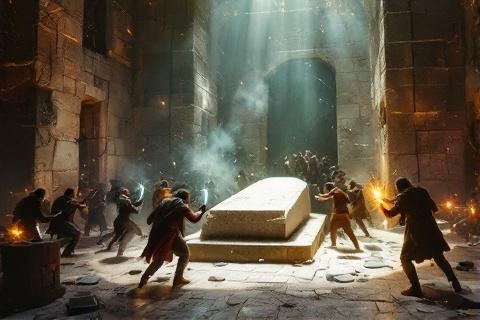
During the events of "The Lord of the Rings," goblins (more commonly referred to
as orcs in these texts) served as the primary foot soldiers in Sauron's vast
armies, demonstrating their continued significance as agents of evil in
Middle-earth. These creatures were organized into military units under the
command of both orc captains and Sauron's human and Nazgûl
lieutenants, forming the backbone of the Dark Lord's military might. Their
presence extended across Middle-earth, from the depths of Moria to the fortress
of Dol Guldur in Mirkwood, the tower of Cirith
Ungol guarding the pass into Mordor, and throughout Mordor
itself. Tolkien describes how Sauron "multiplied" the orcs in preparation for
the War of the Ring, suggesting intensive breeding programs designed to create
sufficient numbers for his planned conquest. Unlike in "The Hobbit," where
goblins operated independently under their own leadership, in "The Lord of the
Rings" most orcs were integrated into Sauron's command structure, though some
groups like those in Moria maintained a degree of autonomy. This integration
into larger evil forces represented a significant evolution in their role in
Middle-earth, transforming them from independent antagonists into coordinated
components of a larger threat to all free peoples.
One of the most memorable encounters with goblins in "The Lord of the Rings"
occurs when the Fellowship of the Ring enters
the ancient dwarf kingdom of Moria, only to discover that it had been completely
overtaken by a large colony of goblins who ambushed them at Balin's Tomb. This
confrontation begins with the ominous sound of drums in the deep, followed by
goblin footsteps and cries approaching from multiple directions, demonstrating
their use of coordinated attacks. Tolkien describes the attack vividly: "With a
terrible cry the Orcs came straight for them. There was a ring and clash of
metal as the hobbits and Gimli hewed at them, and
Aragorn and Boromir did the like." This battle
reveals how the goblins had completely claimed the once-great dwarf kingdom as
their own, turning the magnificent halls and chambers into dark nests filled
with their foul presence. Their occupation of Moria represented a significant
strategic position in the Misty Mountains, giving them control over an important
east-west passage and access to ancient dwarf treasures and craftsmanship. The
attack on the Fellowship demonstrated their territorial nature and immediate
hostility toward intruders, particularly dwarves like Gimli who represented the
race they had displaced from these halls.
The Moria goblins that ambushed the Fellowship were notably accompanied by a
cave troll and led by a large chieftain who nearly killed Frodo with a spear
thrust that would have been fatal if not for the mithril shirt he wore beneath
his clothing. Tolkien describes this leader as "a huge orc-chieftain, almost
man-high" with "black mail" who wielded "a great spear." This description
highlights the hierarchy within goblin forces, with larger, better-equipped
individuals commanding smaller warriors in battle. The inclusion of a cave troll
in their attack force demonstrated the goblins' ability to dominate and direct
other evil creatures, using the troll's immense strength to break through the
barricaded door of the Chamber of Mazarbul. The goblin chieftain's targeting of
Frodo specifically, even though other members of the Fellowship might have
seemed more threatening, suggested either random chance or perhaps some
intuition about the hobbit's importance. This encounter represented one of the
most direct confrontations between the Fellowship and the servants of evil in
the early stages of their quest, foreshadowing the escalating dangers they would
face as their journey continued.
Though the Moria goblins were temporarily defeated at Balin's Tomb, with many
slain by the Fellowship's desperate defense, their presence throughout the mines
forced the Company to flee through the ancient halls rather than rest or search
for alternative routes. Tolkien creates a palpable sense of pursuit as the
Fellowship races through the darkness with "patter, patter, pat, behind" them,
indicating that the goblins were rallying their forces for another attack. This
continuous threat ultimately drove the Company toward the Bridge of Khazad-dûm
where they encountered the Balrog, a far more ancient and terrible evil that the
goblins themselves feared. Gandalf observes that "there are Orcs, very many of
them... And some are large and evil: black Uruks of Mordor," indicating
communication and cooperation between the Moria goblins and Sauron's forces.
This suggests that despite their primarily autonomous existence, the Moria
goblins maintained connections with Sauron's regime and potentially served as
his eyes and ears in the region. Their persistent pursuit of the Fellowship
through the mines demonstrated their territorial nature and relentlessness,
traits that made them effective guardians of their underground realm despite
their individual weakness compared to fighters like Aragorn or Boromir.
Theological and Philosophical Significance of Goblins

In Tolkien's Catholic worldview, goblins represent the corruption of God's
creation by evil forces, rather than being inherently evil from their origin.
This theological concept aligns with Augustine's understanding of evil not as a
substance or essence in itself, but as a privation or perversion of good. By
establishing that goblins were originally Elves who were corrupted by Morgoth's
torture and malice, Tolkien rejects the notion of inherent or original evil in
any created being. This origin story reflects his belief that all of Eru
Ilúvatar's (God's) creations were fundamentally good at their conception, and
that evil could only exist as a corruption of this initial goodness. In a letter
to his publisher, Tolkien wrote that he did not believe in "absolute Evil" as
this would be incompatible with his Catholic faith, which held that all creation
came from God and was therefore initially good. The goblins thus serve as a
powerful metaphor for the theological concept of the Fall and corruption of
creation, representing how beauty and goodness can be twisted into ugliness and
malice through the exercise of evil will and intent. Their very existence poses
profound questions about the nature of evil in Tolkien's universe, suggesting
that it is always derivative rather than original.
The existence of goblins as corrupted beings raises complex moral questions
about free will and redemption, particularly whether creatures so thoroughly
twisted by evil forces retain moral agency and could potentially return to
goodness. Tolkien never provides a definitive answer to this philosophical
puzzle in his works, allowing readers to contemplate these deeper questions
about the nature of evil and the possibility of redemption. Throughout his
narratives, goblins are consistently portrayed as choosing evil actions,
suggesting they retain some form of free will despite their corrupted nature.
However, no examples exist of goblins rejecting their evil tendencies or seeking
redemption, leaving open the question of whether their corruption is so complete
as to make such choices impossible for them. This ambiguity reflects Tolkien's
understanding of the complexity of moral corruption, where patterns of evil can
become so deeply ingrained that choosing good becomes increasingly difficult
without intervention or grace. The moral status of goblins thus serves as a
thought experiment about the limits of corruption and the persistence of moral
responsibility even in beings who have been subjected to powerful evil
influences beyond their control.
Throughout his writings, Tolkien never definitively answers whether goblins have
souls or could potentially be redeemed, leaving readers to contemplate this
theological puzzle in light of their Catholic understanding of salvation. The
question is particularly complex given the goblins' origin as Elves, who in
Tolkien's cosmology possessed immortal spirits that were bound to the world
until its end. If goblins retained the immortal nature of their Elvish origins,
then their spirits would continue to exist even after physical death, raising
the question of their ultimate fate in the cosmic order. In some of his letters
and unpublished writings, Tolkien struggled with this implication of his own
mythology, considering whether beings corrupted by evil might eventually find
healing in the halls of Mandos or after the remaking of the world. He never
reached a conclusive position in his published works, perhaps intentionally
leaving this theological question open as a matter for reader contemplation.
This ambiguity reflects Tolkien's own wrestling with profound theological
questions about evil, corruption, and the possibility of universal redemption
within a Catholic framework that affirms both the reality of evil choices and
the unlimited mercy of God.
Ultimately, the goblins of Tolkien's legendarium serve as a warning about how
darkness can twist and pervert goodness when given the chance, illustrating the
author's concern with the corrupting influence of power, hatred, and cruelty.
Their transformation from beautiful, immortal Elves into creatures of darkness
who hate beauty and light demonstrates the devastating consequences of evil in a
visceral, narrative form that transcends abstract theological discussion. This
cautionary aspect of their portrayal reflects Tolkien's experiences with the
horrors of modern warfare, particularly World War I, which showed him how
ordinary people could be transformed by circumstances into perpetrators of
terrible acts. The goblins remind readers that evil is not merely an external
force but a corrupting influence that can transform good into its opposite when
allowed to take root and grow unchecked. Their origin story thus serves not only
as a piece of fictional mythology but as a moral parable about vigilance against
corruption and the importance of resisting evil influences before they take hold
and transform one's fundamental nature. In this sense, the theological
implications of the goblins extend beyond the boundaries of Middle-earth to
offer readers a framework for understanding the real-world dynamics of
corruption and moral decay.
Legacy and Influence on Fantasy Literature
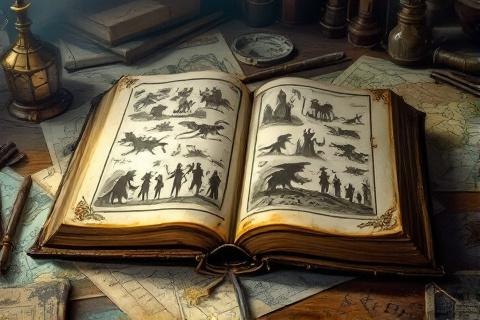
Tolkien's portrayal of goblins dramatically reshaped how these creatures are
depicted in modern fantasy literature, moving them away from the mischievous
fairies of earlier folklore toward the malevolent, organized warriors that now
dominate the genre. Before Tolkien, goblins in European folklore and children's
literature were often portrayed as small, trickster figures who might cause
minor mischief but rarely represented existential threats to humanity. Works
like George MacDonald's "The Princess and the Goblin" depicted them as
underground dwellers with an aversion to light, but Tolkien expanded and
darkened this concept significantly, giving goblins a complex society, military
capabilities, and a cosmic origin story tied to the primary antagonist of his
legendarium. This reimagining established goblins as a serious evil force rather
than mere nuisances, capable of organized warfare and representing a genuine
threat to civilization. Following the publication and widespread popularity of
"The Hobbit" and later "The Lord of the Rings," fantasy authors increasingly
adopted Tolkien's vision of goblins as militaristic, underground-dwelling
creatures with their own culture and capabilities, fundamentally altering how
these beings were conceptualized in the literary imagination and popular
culture.
Tolkien's decision to present goblins as corrupted beings rather than inherently
evil creatures added moral complexity to these antagonists that has influenced
countless fantasy works that followed his pioneering texts. By establishing that
goblins were originally Elves who had been tortured and twisted by dark powers,
Tolkien introduced a tragic dimension to these creatures that raised questions
about culpability, free will, and the nature of evil itself. This origin story
created space for more nuanced portrayals of traditionally "evil" races in later
fantasy works, where authors could explore themes of redemption, moral agency,
and the environmental or social factors that might shape supposedly monstrous
beings. Writers from Terry Pratchett to N.K. Jemisin have engaged with this
legacy, sometimes embracing and sometimes subverting Tolkien's approach by
developing goblin or orc characters capable of kindness, wisdom, or moral
growth. The ethical ambiguity introduced by Tolkien's corruption narrative has
encouraged later fantasy authors to question simplistic good-versus-evil
dichotomies and explore more complex moral landscapes where even traditionally
villainous races might contain individuals capable of transcending their origins
or cultural conditioning.
The underground civilization, technological aptitude, and tribal structure of
Tolkien's goblins became a template for many fantasy writers who followed,
establishing a set of tropes that continue to influence depictions of these
creatures across literature, film, games, and other media. Tolkien's goblins
were not merely monsters but possessed a distinct culture with songs, leadership
hierarchies, craftwork, and military tactics that made them feel like a genuine
society rather than just obstacles for heroes to overcome. Their skill with
machines and tunneling, their aversion to sunlight, their use of curved weapons,
and their alliance with wolf-like creatures have all become standard elements in
goblin portrayals across the fantasy genre. Role-playing games like Dungeons &
Dragons drew heavily from Tolkien's conception, further codifying and spreading
these characteristics throughout popular culture. The technological aspect was
particularly influential, establishing goblins as creatures with a perverted
creativity that manifests in cruel inventions and effective but inelegant
machines. This portrayal created a distinctive niche for goblins in fantasy
ecosystems, differentiating them from other antagonistic races through their
particular combination of underground dwelling, technological aptitude, tribal
organization, and corrupted origin.
